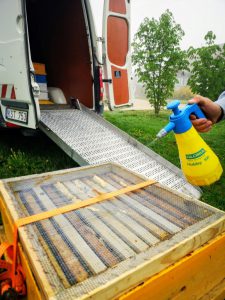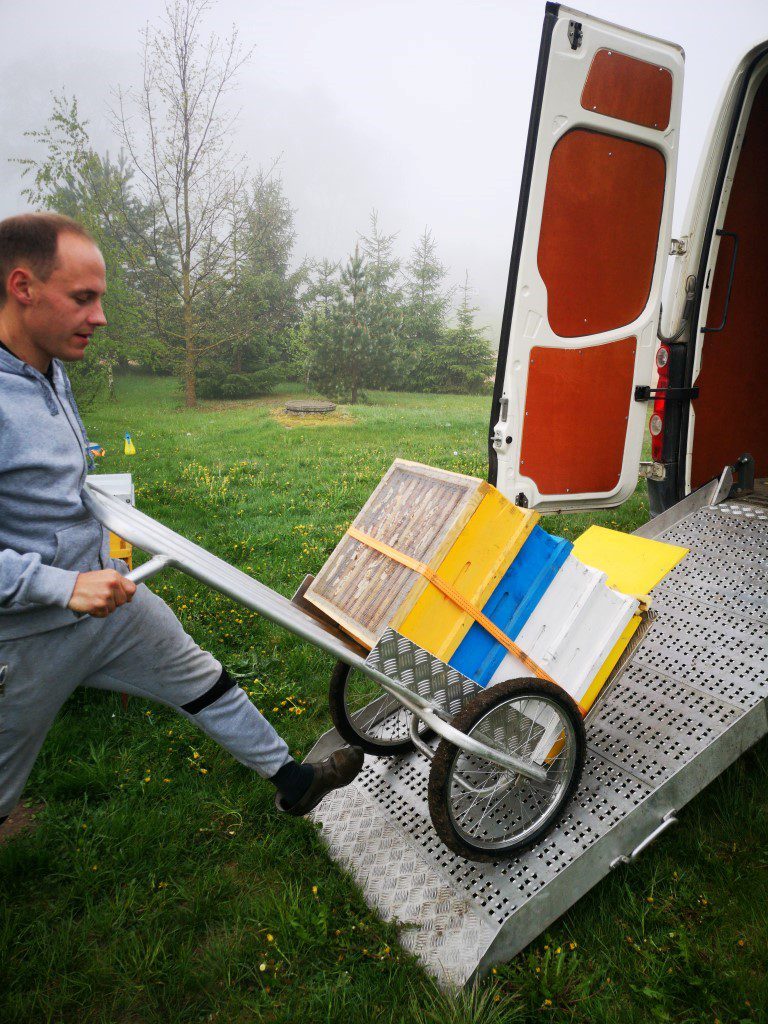Relocating bee colonies
The relocation of bee colonies is not as rare a phenomenon in the beekeeping world as one might think. It helps farmers produce specialty honey, improve honey harvests and add variety to the range of products produced by bees. With the right preparation, relocating hives will not only be uncomplicated, it can also be kind of fun. We’ll share with you how we relocate our bee colonies.
For the bees, spring and summer are the peak seasons. Beekeepers who wish to maximise their harvest, i.e., ensure a constant nectar harvest, send their bees on ‘business trips’ to different meadows every 2–3 weeks, for approximately as long as the plants are in flower. Even though you can’t tell bees what to do or what flower to land on, by relocating their hives to different fields, you can produce specialty honey. However diligent they might be as gatherers of nectar, they first harvest honey from the nearest fields, so if you place a hive by a field of buckwheat, you’ll have some buckwheat honey, and if you place it by the woods, your bees will make forest honey. Even if you don’t produce a pure specialty honey, at least the greater part of the nectar will be gathered from the plants predominant in the area, and so their after-taste and nutritional properties will predominate in your honey.
Is hive relocation necessary if you want to produce honey? It really isn’t. Bees can gather nectar from fields within a radius of a dozen kilometres. You’ll definitely have enough to sweeten your tea. But wouldn’t you want to live closer to your workplace? Bees are no exception in this regard. The closer an abundance of nectar is, the more energy bees can spend on actually gathering nectar instead of commuting to far-away meadows. Nectarful fields can best be found by consulting with local farmers and arranging for the temporary placement of hives on their land. After all, bees work themselves to death over their short lifespan of up to six weeks, so why not save them at least a day of life?
Bees like to move. Especially with their entire hive. When transporting bees to another location, you really need to be careful and respectful, because a hive is full of tens of thousands of capricious bees – anger them at your own risk. Besides, reckless behaviour can cost the lives of some of your bees and even the queen bee herself. So before moving your bees for a week or two, make sure to prepare meticulously well. Preparations are best left to the evening before the move. Before you begin to relocate your bees, extract the existing honey harvest from the hive, so that the bees have room for new stores of honey, and set new and empty honey supers up in the hive. Because bees like comfort, we set up an ‘air conditioner’ for them – attaching a screen to improve airflow at the top and bottom of the hive. Lastly, for our safety and theirs, we secure the hives with fastening straps and wait for the early morning hours.
Relocate the bees before dawn – after all, we want all
members of the family to be at home. So that the bees
don’t come out to explore the car or introduce
themselves to their ‘relocators’, close the entrances to
the hive before loading it into your vehicle. Also
complete the second stage of ‘conditioning’ by
spraying the bees with water. Bees are used to being
their own vehicles and navigators, so your driving
skills might make them stressed. Besides, when
quarters are so close inside the hive, the bees can
overheat quickly, and the likelihood of wax melting
and a portion of the bees dying along the way
increases. The screen for airflow and water spraying
will protect the bees and also give them something to
drink – all the conveniences they could need under one
roof. Once you’ve made the necessary preparations,
load the hives so that the hive frames are
perpendicular to the axles of the vehicle – this will
protect the bees from being squashed – and it’s finally
time to step on the gas pedal. Not all the way,
obviously. Slowly and carefully.
Bees are great trackers. In order to comfortably move them to a different location and prevent them from looking back, you’ll have to travel beyond a 4 km radius. We recommend moving up to 25 bee colonies to the new location. When erecting the hives, it’s important to remember that bees, much like other animals, live and work according to the laws of nature. It is best that entrances are turned towards the east, so that the bees wake up with the first rays of sunlight – this will improve their mood and their nectar harvest. And finally, it’s important to take care of anyone that might wander in to the territory of the relocated hives by setting up an informational stand with your bee farm’s contact information, and inform the State Food and Veterinary Service of the hives’ new location.
If you have a hive or two of these beauties, we hope that you’ll make good use of our tips, and your bees will wake up every morning to fields full of nectar, where they will be able to patiently fly from flower to flower, not even knowing how grateful we are to them for everything we see around us. We wish you a delicious and abundant honey harvest!!







